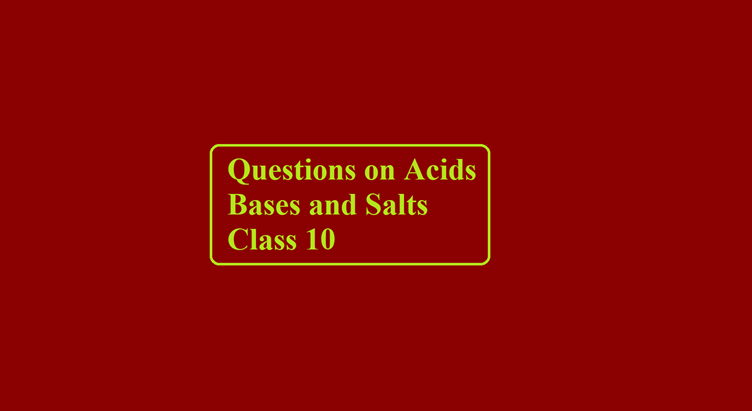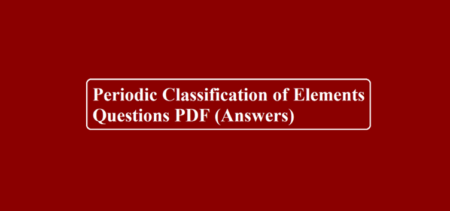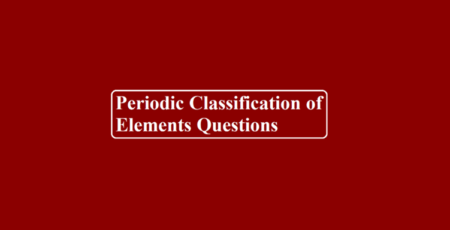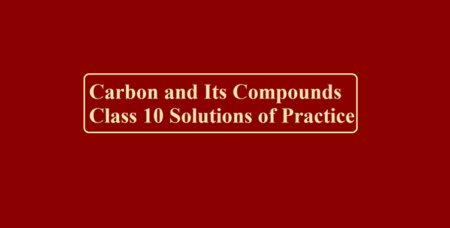Questions on Acids Bases and Salts Class 10
Questions on Acids Bases and Salts Class 10
Que 1. Curd is not kept in copper and brass utensils, why?
Que 2. Equal lengths of magnesium ribbon are taken in test tubes ‘A’ and ‘B’. Hydrochloric acid (HCl) is added to test tube A’ while acetic acid (CH3COOH) is added to test tube ‘B’. In which test tube, will fizzing occur more vigorously and why?
Que 3. (a) Write the name given to the bases that are highly soluble in water. Give an example.
(b) Why does a bee sting cause pain and irritation? Rubbing baking soda on the sting area gives relief. How?
Que 4. Answer the following:
(a) Why is Plaster of Paris written as CaSO4. ½ H2O? How is it possible to have a half-water molecule attached to CaSO4?
(b) Why is sodium hydrogen carbonate an essential ingredient in antacids?
Que 5. A white powder is added while baking bread and while making cakes to make them soft and fluffy. What is the name of that powder? What are the main ingredients in it? What are the functions of each ingredient?
Que 6. What is meant by ‘water of crystallisation’ of a substance? Describe an activity to show that blue copper sulphate crystals contain water of crystallisation.
Que 7. Answer the following questions:
(a) State the colour of phenolphthalein in the soap solution.
(b) Name the by-product of the chloralkali process which is used for the manufacture of bleaching powder.
(c) Name one indicator which specifies the various levels of H+ ion concentration.
Que 8. A substance ‘X’ is used as an antacid and reacts with hydrochloric acid to produce a gas W which is used in fire extinguishers:
(a) Name the substances X and ‘Y’.
(b) Write a balanced equation of the reaction between X and hydrochloric acid.
Que 9. ( a) Define indicator. Name two indicators obtained from plants.
(b) Write a balanced chemical equation for the reaction taking place when sodium oxide reacts with water. How will this solution behave towards phenolphthalein and red litmus paper?
(c) State what happens when sodium hydroxide solution reacts with hydrochloric acid.
Que 10. State the reason for the following statements:
(a) Tap water conducts electricity whereas distilled water does not.
(b) Dry hydrogen chloride gas does not turn blue litmus red whereas dilute hydrochloric acid does.
(c) During the summer season, a milkman usually adds a very small amount of baking soda to fresh milk.
(d) For dilution of acid, acid is added to water and not water to acid.
(e) Ammonia is a base but it does not contain a hydroxyl group.
Questions on Acids Bases and Salts Class 10
Que 11. An acid can react with
(A) AgCl
(B) Na2CO3
(C) AgNO3
(D) None of the above
Que 12. Which of the following statement is correct?
(A) Both bases and alkalies are soluble in water
(B) Alkalies are soluble in water but all bases
(C) Bases are soluble in water but all alkalies are
(D) C2H5OH is a base because it has OH in its formula
Que 13. Which of the following salts does not contain water of crystallisation?
(A) Blue vitriol
(B) Baking soda
(C) Washing soda
(D) Gypsum
Que 14. The nature of toothpaste commonly used to protect against tooth decay is
(A) Acidic
(B) Basic
(C) Neutral
(D) None of the above
Que 15. A new product sodium zincate is formed if sulphuric acid is replaced with
(A) Sodium hydroxide
(B) Sodium oxide
(C) Zinc oxide
(D) water
Que 16. Tomato is a natural source of which acid?
(A) Acetic acid
(B) Citric acid
(C) Tartaric acid
(D) Oxalic acid
Que 17. Lime water reacts with chlorine to give
(A) Bleaching powder
(B) Baking powder
(C) Baking soda
(D) Washing soda
Que 18. Nettle sting is a natural source of which acid?
(A) Methanoic acid
(B) Lactic acid
(C) Citric acid
(D) Tartaric acid
Que 19. Zinc granules on treating with an acid X, form the zinc sulphate (ZnSO4) salt along with the evolution of a gas Y which burns with a pop sound when brought near to a burning candle. Identify the acid X and gas evolved Y
(A). X- Sulphuric acid and Y- Oxygen gas
(B). X- Hydrochloric acid and Y- Oxygen gas
(C). X- Sulphuric acid and Y- Hydrogen gas
(D). X- Hydrochloric acid and Y- Hydrogen gas
Que 20. Indigestion can be treated by using
(A) Antibiotics
(B) Antiseptic
(C) Antacid
(D) All of these
Que 21. Which of the following is a neutral salt
(A) NaCl
(B) Na2SO4
(C) KCl
(D) all of the above
Questions on Acids Bases and Salts Class 10
Questions on Acids Bases and Salts Class 10 (Answers)



